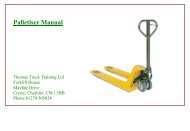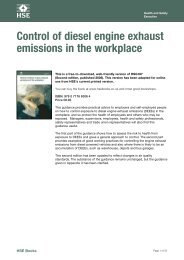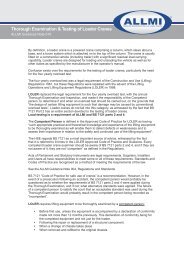Hyster History Part One NewZeland.pdf
Hyster History Part One NewZeland.pdf
Hyster History Part One NewZeland.pdf
- No tags were found...
Create successful ePaper yourself
Turn your PDF publications into a flip-book with our unique Google optimized e-Paper software.
Goughs and <strong>Hyster</strong> – 1945-2005Gough Forklifts celebrate their 60 th Birthday this year, and will be publishing a historyof the <strong>Hyster</strong> brand in New Zealand, from the early post war years to the presentday. The story of Goughs and <strong>Hyster</strong> is an example of a successful long termpartnership – one that started small, and grew steadily into what is now one of themost successful forklift supply companies in the country.From the early days, when <strong>Hyster</strong> manufactured only six models of forklift truck,we’ll be looking at the people, the places, and the machines that have contributed tothe Goughs and <strong>Hyster</strong> story.The Beginning – 1945-1964When Gough Gough & Hamer gained the <strong>Hyster</strong> dealership in 1945, it was almost byaccident. An american company, <strong>Hyster</strong> had a close relationship with one of itsmajor customers, the Caterpillar Tractor Company, to whom it supplied winches andlogging arches, as well as trailers, to suit the Caterpillar D series range of tractors.Many Caterpillar dealers also took on a <strong>Hyster</strong> dealership as well, a natural fit thatresulted in support for the tractor accessories, as well as access to <strong>Hyster</strong>’s othermajor product, forklift trucks.This photo shows the interior of Gough’s Auckland branch, in about 1950. In the leftforeground is a <strong>Hyster</strong> Logging Winch to suit a Caterpillar D4N Tractor.<strong>Hyster</strong> Company had been founded in1929, coincidentally the same year asGough Gough & Hamer. <strong>Hyster</strong>’soriginal machines were steel and lumbercarriers – a version of straddle truckthat continued in production, withupgrades of course, up until the mid1970’s.
The first actual forklift truck was built by <strong>Hyster</strong> in 1935, based on a reversed tractorchassis, and the range was broadened again with the first “Karry Krane”, a uniquelookingvehicle that enjoyed much popularity with the American war machine duringWorld War II.By 1945, <strong>Hyster</strong> had set up an overseas export department, and one of the firstmarkets they secured was in New Zealand, with Gough Gough & Hamer.During 1945, Goughs had access to only six models, starting with the QT20 1 tonner,the YT40 2 tonner, the VT75, RT150, the M2 Straddle Truck and the KC Karry Krane.Records of the time areincomplete, but theearliest recorded salewas of a 1946 <strong>Hyster</strong> M2Straddle Truck – toAuckland-based woodproductsand plywoodcompany Henderson &Pollard. This truck ispictured here, with thephoto taken some timeafter delivery. Thispicture appeared in theNovember 1947 editionof “N.Z National Review”magazine.Henderson & Pollard ordered at least four more <strong>Hyster</strong> Straddles, and Goughsimported the last one in 1959, an M300E. We know that Henderson & Pollard werestill using the <strong>Hyster</strong> straddle trucks in the late 70’s, but by the mid 80’s, the last ofthem had gone. None are known to have survived (but if you know of any, pleasecontact the writer).The other popular truck of the day was the YT40. These forklifts could lift almost2000kg and were great general purpose trucks. Most of the Gough branches aroundthe country had aYT40 as the“workshop hack”.This survivingpicture shows the1954 Christmasparty at Gough’sAuckland branch inStanley Street.Father Christmasarrives at the partybeing carried on aYT40 “Sleigh”.
There are still oneor two YT40’s in usearound the country.Kaiapoi VehicleMaintenance stilloperate a 1947YT40 on a dailybasis. MarkSpencer, picturedrecently with the old<strong>Hyster</strong>, reports thatit’s still on theoriginal engine, andrequires no morethan standardmaintenance andthe odd set of newspark plugs.Is this New Zealand’s oldest <strong>Hyster</strong>? If you know o f any older ones, please contactCraig Armstrong-Fray at Gough Forklifts, on 03 983 2433, or emailcraig.armstrong@ggh.co.nz.Company StructureIn the early days, the management structure of <strong>Hyster</strong> basically fell into the existingcompany structure. No dedicated <strong>Hyster</strong> Sales Representatives, for instance, wereappointed. Sales duties were carried out by Gough Gough & Hamer BranchManagers, and they were expected to sell Caterpillar, <strong>Hyster</strong>, and also the otherbrands that Goughs represented, such as John Deere.In the late forties, Goughs set up the General Industrial Division, into which <strong>Hyster</strong>was placed. In 1950, the manager of this division was Pat Davis. By 1957, theManager was Bill Brittain, a long-serving employee of Goughs who retired in 1993after 43 years of service. As well as <strong>Hyster</strong>, the industrial division supplied CedarRapids crushing plants, Joy mining machinery, generator sets, Skajit loggingmachinery, Northwest shovels and draglines, Athey wagons and elevating graders.The company’s branch network was extensive, even by today’s standards. GoughGough & Hamer had branches in places as diverse as Taumaranui and Timaru, aswell as the usual main centres. The Auckland branch was located on Stanley Street,near what is now the Tennis stadium. This picture from the 1958 Auckland BranchChristmas party shows that, until recently, Stanley St hadn’t changed much in overfifty years.
By 1958, Santahas graduated toa <strong>Hyster</strong> ZA80.Pictured outsidethe Aucklandbranch of GoughGough & Hamer
Health and Safetystandards were noticeablymore relaxed in thosedays, as this picture fromthe Auckland Show in 1956shows. Upon closerinspection, however, thesemen aren’t in as muchdanger as they look. Aspecial clamp attachmen t isholding the timber pack tothe forks. This type ofclamp was popular withtimber merchants of theday, as it allowed forhigher density storage ofthe timber on purpose-builtracks. The machine isanother <strong>Hyster</strong> ZA80.<strong>Hyster</strong> PeopleThe first <strong>Hyster</strong> Salesmen were also Caterpillar and John Deere salesmen. Almostinvariably they also managed the local branch. Around this era, Goughs employeessuch as Ferg Brinsden in Auckland, Wally Nicholson in Christchurch, Stan Hadcroft inWellington, Harry Richards in Palmerston North, Barney Barnes in Rotorua, GeorgeSmith in Hamilton, and Charlie Richardson in Hastings handled any forklift enquiries,as well as placing orders with the factory and managing the servicing. With thegrowth that invariably happened, it wasn’t long before product specialists began toappear, such as Stan Moyle in Palmerston North. In <strong>Part</strong> Two (Post 1964), we’ll lookcloser at some of the people who have helped shape the company into what it istoday.
<strong>Hyster</strong>-RansomesBeginning in 1947, Gough Gough & Hamer also started importing <strong>Hyster</strong>-RansomesElectric forklifts. Formed after <strong>Hyster</strong> took over the British Ransomes company,<strong>Hyster</strong>-Ransomes became a popular addition to Gough’s product lineup. When<strong>Hyster</strong> started designing andmanufacturing its own electricforklifts in 1964, the Ransomesname disappeared. The firstNew Zealand <strong>Hyster</strong>-Ransomescustomer was Christchurch’sD.H. Brown, who operated aflourmill on Moorhouse Ave. In1947, they took delivery of a<strong>Hyster</strong> Ransome TE1H 1 TonPlatform Truck.Early CustomersIn addition to Henderson & Pollard and D.H. Brown, Goughs supplied forklifts to adiverse range of companies, most of whom are still around today in some form oranother. Henderson & Pollard ended up being taken over by Carter Holt Harvey in1987, and formed the nucleus of what is now the Carters retail arm. The old D.H.Brown flourmill on Moorhouse Ave is now operated by Goodman Fielder, still on theoriginal site.Other <strong>Hyster</strong> customers were the Wellington Harbour Board, the Ministry of Works,Odlins, Fletcher Kaiser, Senton Sawmills in Hamilton, Williams and Kettle, A. Ellis andCo, to name just a few, and New Zealand Forest Products, who by 1964 had anextensive range of <strong>Hyster</strong>s.The Next FrontierBy 1964, Goughs had imported at least 396 <strong>Hyster</strong> forklifts, an impressive feat forthe fledgling company in less than 20 years, but bigger challenges were around thecorner. Gough Gough & Hamer enjoyed an excellent relationship with the <strong>Hyster</strong>Company, and had impressed the American Head Office to the extent that they wereabout to offer a rare opportunity. New Zealand was about to become only the tenthcountry in the world to have their own <strong>Hyster</strong> manufacturing plant and Goughs wereabout to embark on a new challenge – the manufacture of <strong>Hyster</strong>s in-house, firstly atthe Sydenham factory in Christchurch, and later at Ensor’s Rd in Woolston. In <strong>Part</strong>Two of this two part series, we’ll be covering the modern history of Gough Forklifts,from 1964 to present day.






